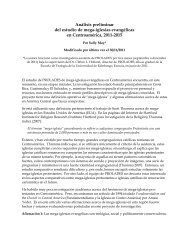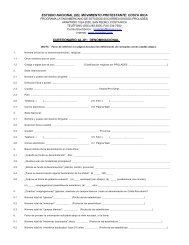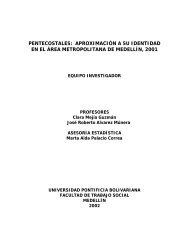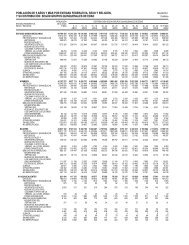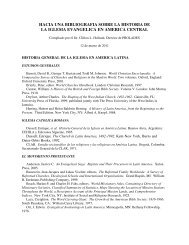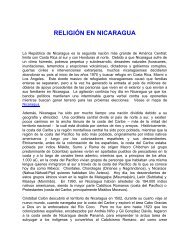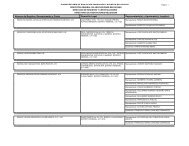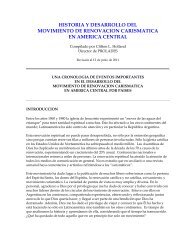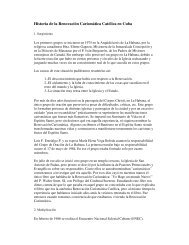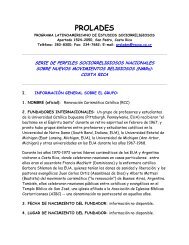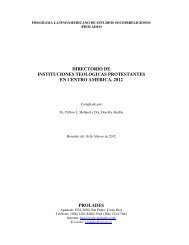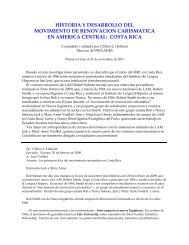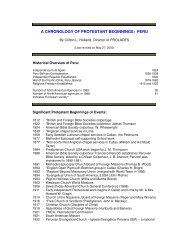belize, 1980 - Prolades.com
belize, 1980 - Prolades.com
belize, 1980 - Prolades.com
Create successful ePaper yourself
Turn your PDF publications into a flip-book with our unique Google optimized e-Paper software.
3.5 OTHERS & NOT STATED (9.5%, <strong>1980</strong> Census):<br />
3.5.1 WHITE EUROPEANS & NORTH AMERICANS (4.2%, <strong>1980</strong> Census)<br />
People of many nationalities live in Belize, but Europeans and North Americans are<br />
especially present in the tourism industry, sports fishing and other <strong>com</strong>mercial enterprises.<br />
Some of the North Americans (US and Canadian citizens) are missionaries or lay volunteers<br />
who serve with a variety of Protestant and Roman Catholic agencies, while others are members<br />
of the various Mennonite <strong>com</strong>munities (5,647 in <strong>1980</strong>). Between 1960 and <strong>1980</strong>, 2,006<br />
Europeans and North Americans immigrated to Belize, according to official census reports.<br />
3.5.2 EAST INDIAN (2,997 or 2.1%, <strong>1980</strong> Census)<br />
Between 1861 and 1891, indentured workers from India (called East Indians) were brought<br />
to Belize by large landowners, who hoped that the importation of these agricultural laborers would<br />
be as successful as in Trinidad and British Guiana. But only a small number of East Indians actually<br />
arrived in Belize, where they worked on the large sugar plantations in Toledo and Corozal districts.<br />
The 1891 Census lists only 291 persons living in the Colony who were born in India. Today, their<br />
descendants still grow rice in the Toledo District or other crops in Corozal District. Most are smallscale<br />
farmers, while others have be<strong>com</strong>e merchants. In <strong>1980</strong>, there were two clearly discernible<br />
settlements: Calcutta in Corazal District in the north and Forest Home near Punta Gorda in Toledo<br />
District in the south. About 47% of this ethnic group lives in these two settlements and the rest live<br />
elsewhere, especially in urban centers: Corozal, Punta Gorda, Belmopan and Belize City. Although<br />
most of the descendents of the early East Indian immigrants no longer speak Hindi, now preferring<br />
to use Creole or Spanish, there are a small number of Hindi-speaking East Indian merchants who<br />
live in Belize City and Orange Walk Town, but they are relative new<strong>com</strong>ers and have no cultural ties<br />
with descendents of earlier East Indian immigrants. Although only 106 people listed Hinduism as<br />
their religious affiliation in <strong>1980</strong>, many others probably have retained some of their Hindu (or<br />
Buddhist, Jain, Sant Mat) beliefs over the years, while others now attend Catholic or Protestant<br />
churches, mainly the Methodist Church.<br />
3.5.3 CHINESE (200-300, <strong>1980</strong> estimate)<br />
During the 1860s, indentured workers from China were imported to the Colony, but the<br />
venture was not very successful, with some dying from disease while others fled to live among the<br />
Amerindians of Yucatan. Descendants of these early Chinese immigrants still live in Belize, but most<br />
of the Chinese population today has arrived since the 1930s. Few have be<strong>com</strong>e Christians. The<br />
majority continue to worship their ancestors, while pursuing age-old cultural and religious traditions<br />
(Confucianism, Taoism and Buddhism) and operating stores, restaurants and lottery sales.<br />
Between 1960 and <strong>1980</strong>, 112 Chinese nationals immigrated to Belize. Most reside in Belize City,<br />
but at least a few Chinese families live in every major town.<br />
3.5.4 SYRIAN-LEBANESE (170-200, <strong>1980</strong> estimate)<br />
Some of the most successful businessmen in Belize are Syrians or Lebanese who have lived<br />
there for two or three generations. Although few in number, Syrians have fulfilled an important role<br />
in the <strong>com</strong>munity, along with Chinese merchants. Family ties are strong but little is known about<br />
their current religious beliefs: some are Arab Muslims (110) while others are Eastern Orthodox<br />
(Maronite) or Roman Catholic. Also, there are a small number of Palestinian immigrants and their<br />
descendents, including a leading Belizean politician—Mr. Said Musa.<br />
15



